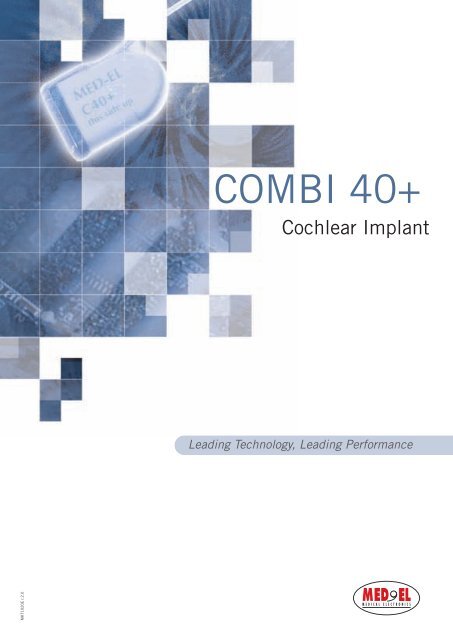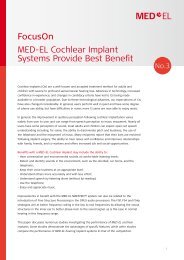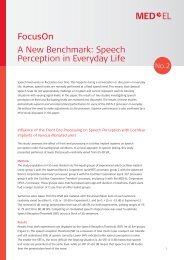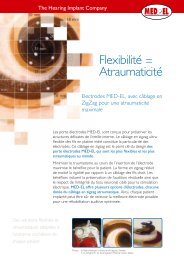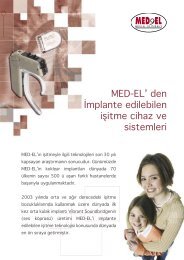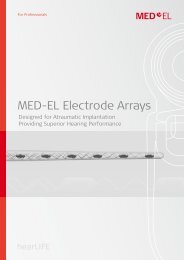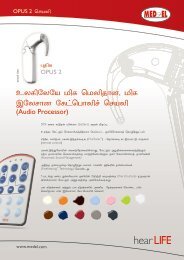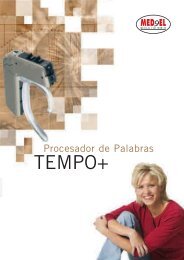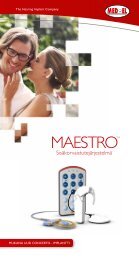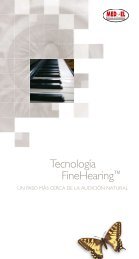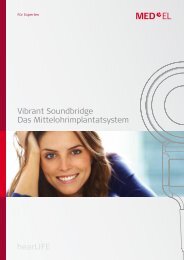You also want an ePaper? Increase the reach of your titles
YUMPU automatically turns print PDFs into web optimized ePapers that Google loves.
MKT1020E r.2.0<br />
COMBI 40+<br />
<strong>Cochlear</strong> <strong>Implant</strong><br />
Leading Technology, Leading Performance
THE MED-EL COMBI 40+ IMPLANT<br />
With a research heritage spanning over 25 years, MED-EL is pioneering cochlear implant technology<br />
and research worldwide. This expertise has led to the development of the COMBI 40+ family of<br />
cochlear implants, specially designed to be atraumatic and minimally invasive while providing users<br />
unparalleled performance.<br />
GENTLE TECHNOLOGY<br />
Soft electrode<br />
The biocompatible silicone array<br />
features recessed electrode contacts<br />
to avoid injury to the delicate<br />
cochlear structures.<br />
Specially designed flexible electrode<br />
The tip and oval cross-section of<br />
the electrode array gently follow<br />
the curvature of the cochlea during<br />
insertion.<br />
Thinnest implant package available<br />
At approx. 4mm thick, the<br />
COMBI 40+ is ideal for use with<br />
even very small children.<br />
Small volume electrode<br />
The electrode array is designed<br />
such that it does not fill or obstruct<br />
the cochlea.<br />
Small cochleostomy required<br />
The small diameter, thin singlebranch<br />
electrode array requires<br />
the smallest cochleostomy of all<br />
implants available. The conical<br />
shape of the electrode shaft and<br />
the marker ring facilitate a tight<br />
cochleostomy seal.<br />
Output capacitors, telemetry,<br />
self-check integrity, and other<br />
features ensure the highest level<br />
of safety.<br />
Engineered for Excellence<br />
A decisive factor in cochlear implantation is to minimise<br />
trauma to the delicate structures of the cochlea. Due to<br />
its unique design features, we believe that the MED-EL<br />
COMBI 40+ represents the current Gold Standard.<br />
Safety features<br />
T. Balkany, Miami<br />
DESIGNED FOR PERFORMANCE<br />
The COMBI 40+ is uniquely designed for deep electrode<br />
insertion (approx. 31mm) for stimulation of the complete<br />
frequency range.<br />
w. Gstöttner<br />
Optimised electrode spacing<br />
for distinct pitch perception<br />
<strong>El</strong>ectrode contact spacing reduces<br />
neural interaction and provides<br />
enhanced speech cues and<br />
more natural sound.<br />
Deep electrode insertion<br />
Deep insertion targets the apical<br />
area of the cochlea where there is<br />
often better neuronal survival.<br />
Representation of low pitch information<br />
at the correct place in the<br />
cochlea may enhance important<br />
speech cues such as intonation,<br />
vowel discrimination and some<br />
binaural cues.<br />
Ceramic housing,<br />
the modern material of choice<br />
The compact, robust ceramic<br />
case is similar in hardness to the<br />
surrounding bone and allows the<br />
transmission of a large amount of<br />
information with low energy requirements.<br />
All components including<br />
the receiver coil are<br />
located in and protected by the<br />
housing.<br />
Optimised stimulation rate<br />
for best performance<br />
The COMBI 40+ features an infinitely<br />
variable stimulation rate<br />
that can be adjusted according to<br />
individual needs.
READY FOR THE FUTURE<br />
Outstanding Results<br />
Technology means nothing without outcomes. MED-EL COMBI 40+ patients demonstrate<br />
outstanding results which range from mean monosyllable scores of 70% 1 to telephone<br />
use 2 and even music enjoyment. 3,4 Additionally, MED-EL COMBI 40+ users<br />
reach high performance levels quickly, reaching mean scores of 84% sentence understanding<br />
as early as 6 months. 1<br />
Given today’s rapid advances in technology, MED-EL is committed to ensuring that cochlear implant recipients are able to<br />
take advantage of future developments and upgrades. MED-EL demonstrates this commitment with the TEMPO+ BTE Speech<br />
processor, the only BTE speech processor which can be used by recipients of both the MED-EL COMBI 40+ and the previous<br />
generation implant, the COMBI 40.<br />
Compatible with future technologies<br />
The flexible design platform and ability to stimulate at high rates allow the COMBI 40+ to be compatible<br />
with future technological upgrades.<br />
MRI safe, no additional surgery necessary<br />
The COMBI 40+ is the only implant available that is MRI safe (0.2, 1.0 and 1.5 Tesla) 5,6,7 without<br />
the need for surgical removal of the magnet, and thus no additional period of deafness<br />
MED-EL's Focus on <strong>El</strong>ectrode Development<br />
<strong>Cochlear</strong> implantation is not only performed on one of the body's smallest<br />
structures, but also on one of the most delicate. For this reason, it is both a<br />
surgical and technical challenge.<br />
Since the foundation of MED-EL, the company's philosophy has been to develop<br />
atraumatic electrodes designed for highest performance and maximum<br />
protection of the cochlea. This is of critical importance because trauma to<br />
the cochlea may increase the potential for post-operative problems and restrict<br />
access to future technological upgrades.<br />
Important considerations include minimisation of mechanical forces applied<br />
to the delicate structures of the cochlea, as well as promotion of a tight<br />
cochleostomy seal to prevent post-operative infection.<br />
MED-EL is committed to focusing research efforts to achieve further improvements<br />
in this area to ensure that our electrodes are not only high performing,<br />
but structure and function preserving.<br />
C. Gary Wright, Ph.D.<br />
University of Texas Southwestern <strong>Med</strong>ical Center,<br />
Dallas, Texas
COMBI 40+ Standard <strong>El</strong>ectrode Array<br />
Meeting Individual Needs<br />
Unique to MED-EL, the COMBI 40+ is available in a range of electrode options to meet individual<br />
needs, such as electrodes for cases of cochlear ossification or malformation.<br />
24 contacts arranged as connected pairs for 12-channel high-rate stimulation<br />
The COMBI 40+ Standard <strong>El</strong>ectrode Array is designed for deep electrode insertion (approx. 31mm)<br />
for stimulation of the complete frequency range. This provides access to more low pitch information<br />
containing important speech cues such as intonation, vowel discrimination and some binaural cues.<br />
COMBI 40+ Compressed <strong>El</strong>ectrode Array (C40+ S)<br />
Specially designed for partial ossification or malformation of the cochlea<br />
The COMBI 40+ Compressed <strong>El</strong>ectrode Array features 12 pairs of electrode contacts equally spaced<br />
over a length of only 12.1 mm. This makes it possible to insert more channels in a partially or<br />
completely ossified cochlea than with a standard electrode.<br />
COMBI 40+ Split <strong>El</strong>ectrode Array (C40+ GB)<br />
Specially designed for complete ossification of the cochlea<br />
The COMBI 40+ Split <strong>El</strong>ectrode Array consists of two separate electrode branches, one with 5 and<br />
one with 7 pairs of electrode contacts. <strong>El</strong>ectrode contacts are spaced at the same distance as in<br />
the Compressed <strong>El</strong>ectrode Array. These active arrays are designed for insertion into two<br />
cochleostomies to maximize the number of inserted electrode contacts and optimize performance.<br />
SPECIAL IMPLANTS FOR SPECIAL CASES<br />
In addition to the electrode arrays discussed above, MED-EL is committed to working with cochlear implant professionals<br />
to provide implant solutions for special anatomical situations. Please contact your nearest MED-EL office for<br />
more information on special implant designs.<br />
1) D'Haese P et al., The investigation of the binaural effect in bilateral cochlear implant users, presented at the XXVI International Congress of Audiology, Melbourne,<br />
March 2002, The Australian and New Zealand Journal of Audiology, Volume 23, Number 2, 2002 Addendum.<br />
2) Sorri et al, <strong>Cochlear</strong> <strong>Implant</strong>s and GSM phones, Scandinavian Audiology 2001, 30: Suppl 52:54-6.<br />
3) Helms J et al., Comparison of the TEMPO+ Ear-level Speech Processor and the CIS PRO+ Body-Worn Processor in Adult MED-EL <strong>Cochlear</strong> <strong>Implant</strong> Users,<br />
ORL 2001; 63:31-40.<br />
4) Stöbich et al., Presented at the 2nd Congress of Asia Pacific Symposium on <strong>Cochlear</strong> <strong>Implant</strong> and Related Sciences, Comparison of performance of the MED-<br />
EL body worn speech processor CIS-PRO+ with the new MED-EL BTE-speech processor TEMPO+ in adults, April 1999.<br />
5) Teissl, et al. Magnetic Resonance Imaging and <strong>Cochlear</strong> <strong>Implant</strong>s: Compatibility and Safety Aspects, Journal of Magnetic Resonance Imaging 9:26-38 (1999)<br />
6) Teissl, et al. <strong>Cochlear</strong> <strong>Implant</strong>s: In Vitro Investigation of <strong>El</strong>ectromagnetic Interference at MR Imaging-Compatibility and Safety Aspects, Radiology, September<br />
1998.<br />
7) Youssefzadeh, et al. MR Compatibility of MED-EL <strong>Cochlear</strong> <strong>Implant</strong>s: Clinical Testing at 1.0 T, J. Comput. Assist. Tomogr 22(3:346-50) 1998.<br />
MED-EL Worldwide Headquarters<br />
Fürstenweg 77a, A-6020 Innsbruck, Austria<br />
Tel: +43-512 28 88 89, Fax:+43-512-29 33 81


